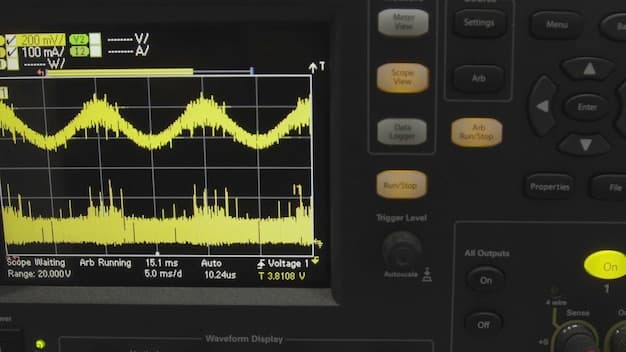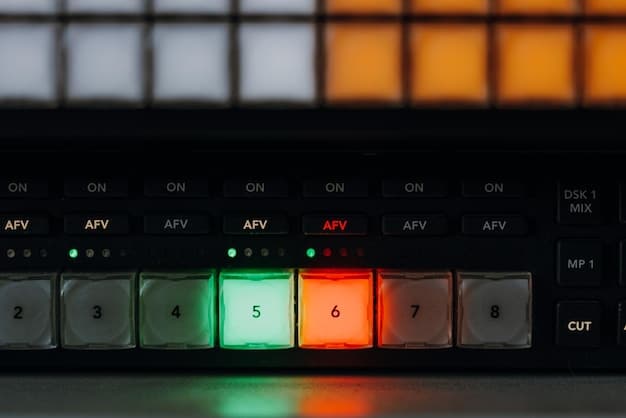Vocal Chain Secrets: Pro Underground Rap Vocals in 2025

Unlock the secrets to a professional vocal sound for underground rap in 2025, exploring essential vocal chain components and techniques for achieving polished, industry-standard results.
Want to get a killer vocal sound for your underground rap tracks in 2025? Discover the vocal chain secrets that will take your recordings from amateur to pro, giving you the polished sound you’ve been dreaming of. Let’s dive in!
Understanding the Vocal Chain for Underground Rap
A vocal chain is the series of audio effects used to process a vocal recording, shaping its tone, adding clarity, and ultimately making it sound professional. For underground rap, a well-crafted vocal chain is crucial for achieving that raw, authentic sound while maintaining a polished, competitive edge.
Building an effective vocal chain involves understanding the function of each component and how they work together to enhance the vocal performance. Let’s break down the essential elements of a modern vocal chain for underground rap in 2025.
The Importance of a Solid Foundation
Before diving into effects, it’s crucial to start with a high-quality recording. This means using a decent microphone, ensuring proper gain staging, and recording in a space with minimal ambient noise.
Key Components of the Vocal Chain
The typical vocal chain consists of several essential plugins, each serving a unique purpose in shaping the final vocal sound. These include EQ, compression, de-essing, and more.
- EQ (Equalization): Used to shape the tonal balance of the vocal, removing unwanted frequencies and boosting desirable ones.
- Compression: Reduces the dynamic range of the vocal, making it more consistent and easier to mix.
- De-essing: Controls sibilance (harsh “s” sounds) to prevent distracting artifacts in the recording.
- Delay and Reverb: Adds depth and space to the vocal, creating a sense of atmosphere and dimension.
By understanding the purpose of each plugin, you can begin to craft a vocal chain that complements your unique vocal style and the overall vibe of your music. Experimentation is key to finding the perfect balance.
Essential EQ Techniques for Rap Vocals
Equalization (EQ) is a critical tool for shaping the sound of your rap vocals. It allows you to sculpt the frequency spectrum, removing muddiness, adding clarity, and enhancing the overall presence of the vocal. Learning to use EQ effectively is essential for achieving a professional sound.
The goal of EQ is to create a balanced and polished vocal that sits well in the mix. This involves identifying and addressing problem areas in the frequency spectrum.

Identifying Problem Frequencies
Before making any adjustments, it’s important to listen carefully to your vocal recording and identify any problematic frequencies. Common issues include muddiness in the low-mids, harshness in the high-mids, and excessive sibilance in the high frequencies.
Boosting and Cutting Frequencies
Once you’ve identified the problem areas, you can begin to make adjustments using EQ. Generally, cutting frequencies is more effective than boosting, as it reduces unwanted noise and creates a cleaner sound.
- Low Frequencies (Below 250Hz): Often contains muddiness and rumble. Use a high-pass filter to remove unwanted low-end frequencies.
- Low-Mid Frequencies (250Hz – 500Hz): Can sound boxy or muddy. Make subtle cuts in this range to improve clarity.
- Mid Frequencies (500Hz – 3kHz): Contains the fundamental frequencies of the vocal. Boost or cut in this range to enhance or reduce presence.
- High Frequencies (3kHz – 8kHz): Adds clarity and brightness. Be careful not to over-boost this range, as it can sound harsh.
- High Frequencies (Above 8kHz): Adds air and sparkle. Use sparingly to avoid sibilance.
Effective EQ techniques can dramatically improve the clarity and impact of your rap vocals, helping them to stand out in the mix. Remember to use your ears and make subtle adjustments to achieve the best results.
Compression: Taming the Dynamics of Your Vocals
Compression is another essential tool in the vocal chain, used to reduce the dynamic range of your vocal recording. This means making the quieter parts louder and the louder parts quieter, resulting in a more consistent and controlled sound. For underground rap, compression is crucial for ensuring that your vocals cut through the mix and deliver a powerful performance.
Understanding how compression works is essential for achieving the desired effect. It’s not simply about making the vocal louder; it’s about shaping the dynamics and creating a more engaging listening experience.
Understanding Compression Parameters
Compression plugins typically have several parameters that control how the compression is applied. These include threshold, ratio, attack, and release.
Compression Techniques for Rap Vocals
There are several different approaches to compression that you can use to achieve different results. Experiment with different settings to find what works best for your vocal style and the overall vibe of your track.
- Setting the Threshold and Ratio: Adjust these parameters to control how much compression is applied. Lower the threshold to compress more of the signal and increase the ratio to compress the signal more aggressively.
- Adjusting Attack and Release: Affects how quickly the compressor reacts to the incoming signal. Use a faster attack for more aggressive compression and a slower attack for more subtle compression. Adjust the release time to control how quickly the compressor stops compressing after the signal drops below the threshold.
- Using Multiple Compressors: Applying multiple compressors in series, each with subtle settings, can result in a smoother, more natural-sounding compression.
Mastering compression techniques can significantly enhance the impact and clarity of your rap vocals, giving them the punch and consistency they need to stand out in the mix. Don’t be afraid to experiment and find what works best for you.
De-essing: Eliminating Harsh Sibilance
Sibilance refers to the harsh “s” and “t” sounds that can occur in vocal recordings. These sounds can be distracting and unpleasant, especially when amplified in the mix. De-essing is the process of reducing or eliminating sibilance using a de-esser plugin.
A de-esser is a specialized compressor that targets the high-frequency range where sibilance typically occurs. It works by detecting these harsh sounds and attenuating them, resulting in a smoother, more balanced vocal.

How De-essers Work
De-essers typically have controls for adjusting the frequency range where the de-essing is applied, as well as the threshold that determines when the de-esser activates.
Using a De-esser Effectively
Using a de-esser effectively involves carefully adjusting the settings to target the sibilance without affecting the overall tone of the vocal. This requires a delicate touch and careful listening.
- Identifying Sibilant Frequencies: Use a spectrum analyzer to identify the frequencies where sibilance is most prominent. This will help you narrow down the frequency range of the de-esser.
- Setting the Threshold: Adjust the threshold so that the de-esser only activates when sibilance is present. Avoid setting the threshold too low, as this can result in a lisping sound.
- Using the Sidechain: Use a sidechain to isolate the sibilant frequencies and trigger the de-esser more accurately.
By mastering de-essing techniques, you can eliminate harsh sibilance and achieve a smoother, more professional-sounding vocal. A well-de-essed vocal will be less fatiguing to listen to and will sit better in the mix.
Adding Depth and Space with Delay and Reverb
Delay and reverb are essential effects for adding depth and space to your vocals. They can create a sense of atmosphere and dimension, making your vocals sound more engaging and professional. For underground rap, these effects can be used to create a variety of different vibes, from intimate and atmospheric to expansive and energetic.
Understanding how delay and reverb work is crucial for achieving the desired effect. It’s not simply about adding these effects indiscriminately; it’s about using them strategically to enhance the emotional impact of your music.
Understanding Delay and Reverb Parameters
Delay and reverb plugins typically have several parameters that control how the effects are applied. These include delay time, feedback, reverb time, and pre-delay.
Creative Use of Delay and Reverb
There are countless ways to use delay and reverb creatively to enhance your vocals. Experiment with different settings and techniques to find what works best for your style and the overall vibe of your track.
- Using Short Room Reverb: Creates a sense of space without sounding too artificial.
- Using Long Plate Reverb: Adds a lush, expansive sound to your vocals.
- Using Slapback Delay: Creates a retro, vintage vibe.
- Using Ping-Pong Delay: Creates a more dynamic and stereo-widened sound.
By mastering the creative use of delay and reverb, you can add depth, space, and character to your rap vocals, making them sound more engaging and professional. Remember to use these effects sparingly and strategically to avoid muddying up your mix.
Advanced Vocal Chain Techniques for 2025
As technology advances, new techniques and tools are constantly emerging in the world of music production. In 2025, there are several advanced vocal chain techniques that can help you achieve a truly cutting-edge sound for your underground rap vocals.
These techniques go beyond the basics and involve experimenting with advanced plugins and unconventional processing methods.
Vocal Doubling and Layering
Vocal doubling involves recording multiple takes of the same vocal part and layering them together to create a thicker, more powerful sound. This technique can add depth and dimension to your vocals, making them sound more impactful.
Using Vocal Exciter Plugins
Vocal exciter plugins add harmonics and saturation to your vocals, enhancing their presence and clarity. These plugins can be used to add warmth, brightness, and edge to your vocals, making them sound more exciting and engaging.
- Experimenting with Saturation: Add subtle saturation to your vocals to warm them up and add character.
- Using Harmonic Exciter Plugins: Enhance the harmonic content of your vocals to make them sound brighter and more present.
- Trying Creative Effects: Use creative effects like distortion, flanging, and phasing to add unique textures to your vocals.
Staying up-to-date with the latest techniques and tools is essential for achieving a competitive edge in the world of music production. By experimenting with these advanced vocal chain techniques, you can push the boundaries of your creativity and achieve a truly unique and professional sound for your underground rap vocals in 2025.
| Key Takeaways | Brief Description |
|---|---|
| 🎤 Vocal Chain Basics | It covers the essentials of a vocal chain for underground rap. |
| 🎛️ EQ Techniques | Details on using EQ to shape rap vocals by removing muddiness and adding clarity. |
| 🔊 Compression | Discusses compression, which reduces the dynamic range of vocals, making the sound more consistent. |
| ✨ Depth and Reverb | Explains adding depth with short room and long plate reverbs. |
FAQ
▼
A vocal chain is a sequence of audio processors (plugins) used to enhance a vocal track. It typically includes EQ, compression, de-essing, and effects like reverb and delay, each shaping your vocals to sound polished.
▼
EQ helps to clean and sculpt the vocal’s frequency range. By cutting muddy or harsh frequencies and boosting clarity, EQ ensures your vocals sit well within the overall mix.
▼
Compression reduces the dynamic range, making the quiet parts louder and the loud parts quieter. It creates a consistent and controlled vocal, perfect for keeping the energy of the track high.
▼
A de-esser is used to reduce or eliminate harsh “s” and “t” sounds. De-essing avoids listener fatigue and allows the vocals to be more pleasant and professional.
▼
Reverb and delay add depth, space, and dimension to the vocals. Reverb creates a sense of where the vocal resides; delay makes it feel more musical and helps fill the soundscape.
Conclusion
Mastering the vocal chain secrets is essential for getting a professional sound for your underground rap in 2025. With the right tools and techniques, you can transform your raw vocal recordings into polished, impactful tracks that stand out in the industry. Experiment, refine, and always trust your ears to achieve the sound you’re aiming for.





